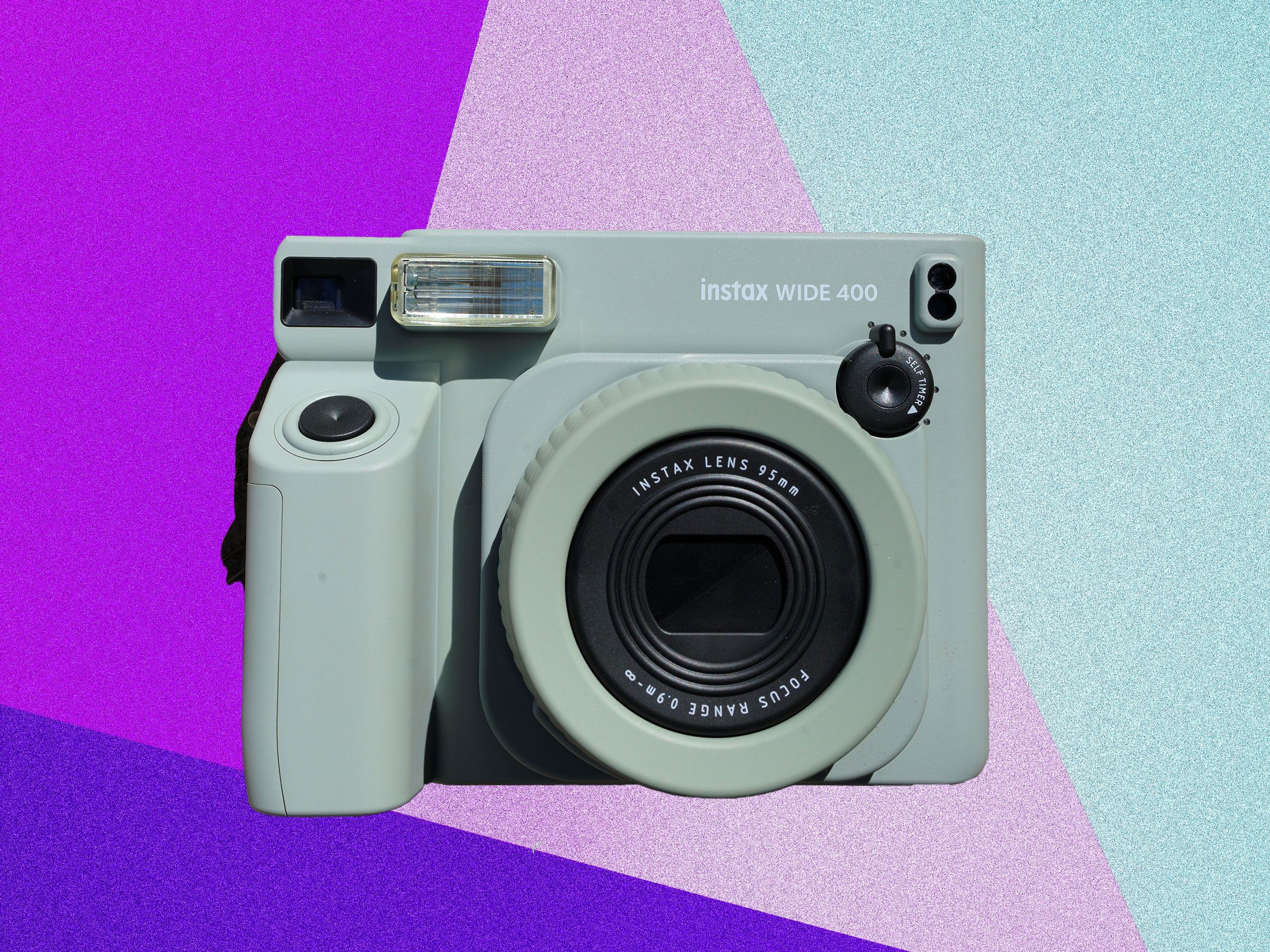All products featured on Wired are independently selected by our editors. However, we may receive compensation from retailers and/or from purchases of products through these links.
-
Photograph: Scott Gilbertson
The Best Instax Wide Camera
Fujifilm Instax Wide 400
Go big or go home. The Instax Wide’s larger image has always made it the Instax of choice for photographers. Ingenious enthusiasts even figured out how to mod older models (the Wide 300) with custom lenses for even better quality images. The Instax Wide 400 is similar in most ways to the 300 that preceded it. It uses the same lens and the same full auto exposure system. If you want full exposure control, this is not the Instax for you. That said, I love this format and hence this camera.
It’s a rather chunky thing. The film is pretty good sized, so the camera is as well, but for me that just makes it easier to hold than some of the others here. There’s a nice big grip, which holds the 4 AA batteries, enough to shoot 100 images according to Fujifilm’s specs. Design-wise, the single color look is reminiscent of the SQ1 (see above), spare and simple. The 95mm f/14 lens is made of two elements (both plastic) and gives you the equivalent of a 35mm focal length on a full frame camera. Fujifilm did add a new close focus option to go with the 10 foot to infinity focus. I wish Fuji had reversed the order, as I sometimes forgot to turn the lens of the second click and ended up with out-of-focus images. Once you get used to it, though, it’s fine.
There’s not a lot to this camera, and that’s part of its appeal. The lens produces decent images, and large format makes it more fun to share with friends. I do wish there were a way to manually control … something, anything, as that would open up some more possibilities, but if you like this format this is the best camera to get.
Other Instax Wide Cameras:
Lomography Lomo’Instant Wide for $200: If you want to spend a bit more, Lomography’s Instant Wide shoots Instax Wide film and has some extra lenses you can add on. It shoots in both full auto and offers a programmatic shutter mode. I haven’t tested this one yet, so I can’t speak to the image quality, but the built-in 90mm Lens is roughly the same field of view.
Fujifilm Wide Evo for $350: At first glance the Wide Evo looks like a clone of our top pick, the Mini Evo, but for the wider format Instax film. Would that it were so. There are some similarities. You get the filter effects, a couple of new lens filters, and the “intensity” ring, which allows you to dial in how strong the various effects are. The lens can switch between wide angle (16-mm full-frame equivalent) and standard (28-mm full-frame equivalent), and there’s dials for controlling all the effects. The shutter button is an annoying lever-style shutter, where you flip down, rather than a button you press. This head-scratching design decision is, um, not good. It’s awkward and mars the experience of shooting in irredeemable ways in my experience. Combine that with a nasty shutter lag (even by Instax standards) and the $350 price tag, and this one is hard to recommend. If you want a printer, go for the Instax Wide. If you want a camera, either the Wide 400 or the Lomography Lomo’Instant Wide are better deals and better cameras.
-
Photograph: Scott Gilbertson
Don’t Need Another Camera? Get an Instax Printer
Fujifilm Instax Link Wide Printer
While I have a certain nostalgia for instant photos, and I own several Instax cameras, the truth is most of the time I make instant images using an Instax photo printer. Sure it’s really just a smartphone printer that doesn’t need ink, but I already have a digital camera and the results I get pairing images from a real camera with an Instax printer outshine what I get from Instax cameras. If you already have a good point and shoot digital camera, or a solid smartphone camera, an Instax printer is the way to go.
My favorite Instax printer is the Link Wide. I just love the bigger images of the Link Wide. The Link Wide connects via Bluetooth and uses its own app, the Link Wide app (iOS, Android). There are some nice extras in the app, like the ability to print multiple images in one print with collage print, or add fun features to your images like hearts, or (shudder) glitter, or any other of the 15 editable templates in the app. One feature I don’t use much, but might be handy for social media is the ability to add QR codes to your images. For example you can add a QR code with a link to a recipe to your photo of the result to then share on social media. There are also some 1,600 in-app “stickers” that let you put clip-art-style overlays on your images. It might sound kind of corny, but these effects are actually quite fun, especially if you have young children.
Awesome Alternatives:
Instax Mini Link 2 for $100: As the name implies, the Mini Link 2 film size is mini prints. Overall print quality is about the same as our top pick, the Evo Mini hybrid, but you lose the camera functions to save $100. And the Link 2 does have a few novel tricks. The Mini Link 2 can print in two different modes, print mode and fun mode. Print mode prints vertically-oriented images, while fun mode is for printing horizontally. The clever twist that the Link 2 added is that if you stand the it upright, the app will recognize that and print vertically (print mode). Lay down the Link 2 and the app will switch to fun mode and print horizontally. It’s a gimmick, but it’s kinda fun. The other fun thing is something called INSTAXAiR, which allows you to add effects and doodles to images by “painting” with an LED light on the side of the Link 2. This is harder to describe than it is to do, but you draw with the printer, what you trace is recorded in the app, and then it prints. Again, sort of gimmicky and not something I use much, but fun to try every now and then. My only real gripe is that the Link 2 is still uses USB-A. Not a deal breaker, but unfortunate.
Instax Square Link for $132: The one Instax printer I have not tested, the Square Link is the way to go if you love the square prints. I have (and still use) the older SP-3, which is essentially the same, though the Square Link uses a different (and much better) smartphone app. Most of the features found in the Mini Link are also available for the Square Link, the main difference being that you print square images, and the Square Link charges by USB-C.
Other Instax Cameras and Printers
Fujifilm is constantly refreshing its Instax lineup, adding new features like parallax correction and faster USB-C charging, which almost all Instax cameras now offer. In some cases though the company has not stopped selling the old models. In general, we suggest sticking with the latest models, but sometimes you’ll find deep discounts on older models. Here are a few other models that are worth considering.
Instax Pal for $80: Late last year, Fujifilm introduced the Pal, a tiny digital camera that you can also buy bundled with an Instax Mini Link 2 smartphone printer and a 10-pack of Instax Mini film. I have not tried the Pal yet, but I struggle to understand who needs it. You can get many of the same features in the Mini Evo, but maybe the Evo is less likely to stand up to life in a child’s hands? I’ll be testing this one soon and will report back.
Instax SQ 6 for $150-$200: This one is a head-scratcher to me. As noted above, the SQ 6 is a better camera than either the SQ 1 or SQ 40, which seem to have jointly replaced the SQ 6. Heck, there was even a Taylor Swift version of the SQ 6 (I’d hate to see what that’s going for on eBay). Whatever the case, Fujifilm no longer lists the SQ 6 on its Instax website. Still, if you like the square format, the SQ 6 is a fantastic camera. It has a number of manual features not found in the others—I especially like the Lighten and Darken modes, which can be used like exposure compensation—in addition to the fully automatic mode of the SQ 40. There are some nice extras like a selfie timer, close up mode, and the ability to turn off the flash. There appears to still be a fair bit of new old stock out there, so if you can find this one for around $100-$150 and you love the Square film, I say go for it.
Instax Mini 11 for $80-$120: This one is covered above, but in case you missed it the Mini 11 is almost never worth buying. It’s only a few dollars cheaper than the newer Mini 12 and lacks most of the features that make the Mini 12 such a good buy. If you can find this one for under $50, maybe it’s worth it, but otherwise avoid the Mini 11.
Instax Mini Link Printer for $145: Fujifilm’s Instax Mini Link was replaced by the Mini Link 2, but the upgrades were minor and, honestly, I can’t tell any difference in print quality. If you can find the original Mini Link for less than the price of the Link 2, go for it. The Link 2 sells for $100 most of the time, so if you can find the Link for less, grab one. They’re both great printers.
Instax 7s/8/9: These are all older, low-end Instax models. They all use a fixed 1/60 shutter speed, whereas the comparably-priced Mini 12’s auto exposure can choose between 1/2 to 1/250 second shutter speeds, making it much more flexible. Given that most of these are hard to find anyway, give them a pass.




